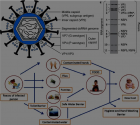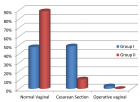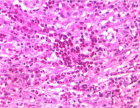Abstract
Research Article
Role of toll-like receptors and their ligands in adipocyte secretion
A Mishra*, AV Shestopalov, AM Gaponov, IA Alexandrov and SA Roumiantsev
Published: 08 April, 2021 | Volume 5 - Issue 1 | Pages: 001-007
Background: Adipose tissue is one of the main sites of energy homeostasis that regulates whole body metabolism with the help of adipokines. Disruption in its proper functioning results in adipose tissue remodeling (primarily hypertrophy and hyperplasia) which directly influences the secretion of said adipokines. Obesity characterized as chronic low-grade inflammation of the adipose tissue is one such condition that has far reaching effects on whole body metabolism. Inflammation in turn results in immune cells infiltrating into the tissue and further promoting adipocyte dysfunction.
Purpose: In our study we explored this adipose tissue-innate immunity axis by differentiating adipose tissue derived stem cells (ADSCs) into white and beige adipocytes. We further stimulated our cultures with lipopolysaccharide (LPS), flagellin, or meteorin-like, glial cell differentiation regulator (METRNL) to trigger an inflammatory response. We then evaluated Toll-like receptor (TLR) mRNA expression and secretion of interleukin (IL-6), interleukin-8 (IL-8), brain-derived neurotrophic factor (BDNF), and nerve growth factor (NGF) in these cultures.
Results: We found that TLR2 is the highest expressed receptor in adipocytes. Further, LPS and METRNL are strong activators of TLR2 in white and beigeBMP7(-) adipocytes. TLR4 was not significantly expressed in any of our cultures despite LPS stimulation. TLR9 expression is upregulated in ADSCs upon LPS and METRNL stimulation. IL-6 and IL-8 secretion is increased upon LPS stimulation in white adipocytes. METRNL activates both IL-6 and IL-8 expression in adipocyte cultures. Lastly, BDNF and NGF is secreted by all adipocyte cultures with beigeBMP7(-) and beigeBMP7(+) secreting slightly higher amounts in comparison to white adipocytes.
Conclusion: ADSCs and adipocytes alike are capable of expressing TLRs, but white adipocytes remain the highest expressing in both control and stimulated cultures. TLR2 is highly expressed in white and beige adipocytes whereas TLR4 showed no significant expression. LPS and METRNL trigger IL-6 and IL-8 secretion in adipocytes. Products of white adipocyte “browning” are capable of secreting higher amounts of BDNF and NGF in comparison to white adipocytes.
Read Full Article HTML DOI: 10.29328/journal.apb.1001012 Cite this Article Read Full Article PDF
Keywords:
Adipocytes; LPS; Flagellin; Meteorin-like peptide (METRNL); TLR; Inflammation
References
- Blüher M, Mantzoros CS. From leptin to other adipokines in health and disease: Facts and expectations at the beginning of the 21st century. Metabolism. 2015; 64: 131–145. PubMed: https://pubmed.ncbi.nlm.nih.gov/25497344/
- Villarroya J, Cereijo R, Villarroya F. An endocrine role for brown adipose tissue? Am J Physiol Endocrinol Metab. 2013; 305; E567-72. PubMed: https://pubmed.ncbi.nlm.nih.gov/23839524/
- Lundgren P, Thaiss CA. The microbiome-adipose tissue axis in systemic metabolism. Am J Physiol Gastrointest Liver Physiol. 2020; 318: G717-724. PubMed: https://pubmed.ncbi.nlm.nih.gov/32068441/
- Kane H, Lynch L. Innate Immune Control of Adipose Tissue Homeostasis. Trends Immunol. 2019; 40: 857–872. PubMed: https://pubmed.ncbi.nlm.nih.gov/31399336/
- Li ZY, Song J, Zheng SL, Fan MB, Guan YF, et al. Adipocyte Metrnl Antagonizes Insulin Resistance Through PPARγ Signaling. Diabetes. 2015; 64: 4011–4022. PubMed: https://pubmed.ncbi.nlm.nih.gov/26307585/
- Fain JN. Release of Interleukins and Other Inflammatory Cytokines by Human Adipose Tissue Is Enhanced in Obesity and Primarily due to the Nonfat Cells. Vitam Horm. 2006; 74: 443–477. PubMed: https://pubmed.ncbi.nlm.nih.gov/17027526/
- Fresno M, Alvarez R, Cuesta N. Toll-like receptors, inflammation, metabolism and obesity. Arch Physiol Biochem. 2011; 117: 151–164. PubMed: https://pubmed.ncbi.nlm.nih.gov/21599616/
- Zhang J, Diao B, Lin X, Xu J, Tang F. TLR2 and TLR4 mediate an activation of adipose tissue renin-angiotensin system induced by uric acid. Biochimie. 2019; 162: 125–133. PubMed: https://pubmed.ncbi.nlm.nih.gov/31002842/
- Vitseva OI, Tanriverdi K, Tchkonia TT, Kirkland JL, McDonnell ME, et al. Inducible Toll-like Receptor and NF-κB Regulatory Pathway Expression in Human Adipose Tissue. Obesity. 2008; 16: 932–937. PubMed: https://pubmed.ncbi.nlm.nih.gov/18292749/
- Poulain-Godefroy O, Froguel P. Preadipocyte response and impairment of differentiation in an inflammatory environment. Biochem Biophysi Res Commun. 2007; 356: 662–667.
- Yan Z-qun. Regulation of TLR4 Expression Is a Tale About Tail. Arterioscler Thromb Vasc Biol. 2006; 26: 2582–2584. PubMed: https://pubmed.ncbi.nlm.nih.gov/17110607/
- Bae J, Ricciardi CJ, Esposito D, Komarnytsky S, Hu P, et al. Activation of pattern recognition receptors in brown adipocytes induces inflammation and suppresses uncoupling protein 1 expression and mitochondrial respiration. Am J Physiol Cell Physiol. 2014; 306; C918-930. PubMed: https://pubmed.ncbi.nlm.nih.gov/24627558/
- Thomalla M, Schmid A, Neumann E, Pfefferle PI, Müller-Ladner U, et al. Evidence of an anti-inflammatory toll-like receptor 9 (TLR 9) pathway in adipocytes. J Endocrinol. 2019; 240: 325–343. PubMed: https://pubmed.ncbi.nlm.nih.gov/30508414/
- Zheng SL, Li ZY, Song J, Liu JM, Miao CY. Metrnl: a secreted protein with new emerging functions. Acta Pharmacologica Sinica. 2016; 37: 571–579. PubMed: https://pubmed.ncbi.nlm.nih.gov/27063217/
- Li ZY, Fan MB, Zhang SL, Qu Y, Zheng SL, et al. Intestinal Metrnl released into the gut lumen acts as a local regulator for gut antimicrobial peptides. Acta Pharmacologica Sinica. 2016; 37: 1458–1466.
- Ghosh SS, Wang J, Yannie PJ, Ghosh S. Intestinal Barrier Dysfunction, LPS Translocation, and Disease Development. J Endocr Soc. 2020; 4: bvz039. https://www.ncbi.nlm.nih.gov/pmc/articles/PMC7033038/
- Bruun JM, Pedersen SB, Richelsen B. Regulation of Interleukin 8 Production and Gene Expression in Human Adipose Tissue in Vitro1. J Clin Endocrinol Metab. 2001; 86: 1267–1273. PubMed: https://pubmed.ncbi.nlm.nih.gov/11238519/
- Castro AM, Macedo-de la Concha LE, Pantoja-Meléndez CA. Low-grade inflammation and its relation to obesity and chronic degenerative diseases. Revista Médica del Hospital General de México. 2017; 80: 101–105.
- Kristóf E, Klusóczki Á, Veress R, Shaw A, Combi ZS, et al. Interleukin-6 released from differentiating human beige adipocytes improves browning. Exp Cell Res. 2019; 377: 47–55. PubMed: https://pubmed.ncbi.nlm.nih.gov/30794803/
- Hoareau L, Bencharif K, Rondeau P, Murumalla R, Ravanan P, et al. Signaling pathways involved in LPS induced TNFalpha production in human adipocytes. J Inflamm. 2010; 7: 1. PubMed: https://pubmed.ncbi.nlm.nih.gov/20148136/
- Severinsen MC, Pedersen BK. Muscle–Organ Crosstalk: The Emerging Roles of Myokines. Endocrine Rev. 2020; 41: 594–609. PubMed: https://pubmed.ncbi.nlm.nih.gov/32393961/
- Chaldakov GN, Fiore M, Stankulov IS, Hristova M, Antonelli A, et al. NGF, BDNF, leptin, and mast cells in human coronary atherosclerosis and metabolic syndrome. Arc Physiol Biochem. 2001; 109: 357-360. PubMed: https://pubmed.ncbi.nlm.nih.gov/11935372/
- Nakagomi A, Okada S, Yokoyama M, Yoshida Y, Shimizu I, et al. Role of the central nervous system and adipose tissue BDNF/TrkB axes in metabolic regulation. NPJ Aging Mech Dis. 2015; 1: 15009. PubMed: https://pubmed.ncbi.nlm.nih.gov/28721258/
- Marosi K, Mattson MP. BDNF mediates adaptive brain and body responses to energetic challenges. Trends Endocrinol Metab. 2014; 25: 89–98. PubMed: https://pubmed.ncbi.nlm.nih.gov/24361004/
- Villarroya F, Cereijo R, Villarroya J, Giralt M. Brown adipose tissue as a secretory organ. Nature Reviews Endocrinology. 2016; 13: 26–35. PubMed: https://pubmed.ncbi.nlm.nih.gov/27616452/
Figures:
Similar Articles
-
Role of toll-like receptors and their ligands in adipocyte secretionA Mishra*,AV Shestopalov,AM Gaponov,IA Alexandrov,SA Roumiantsev. Role of toll-like receptors and their ligands in adipocyte secretion. . 2021 doi: 10.29328/journal.apb.1001012; 5: 001-007
Recently Viewed
-
Sinonasal Myxoma Extending into the Orbit in a 4-Year Old: A Case PresentationJulian A Purrinos*, Ramzi Younis. Sinonasal Myxoma Extending into the Orbit in a 4-Year Old: A Case Presentation. Arch Case Rep. 2024: doi: 10.29328/journal.acr.1001099; 8: 075-077
-
Timing of cardiac surgery and other intervention among children with congenital heart disease: A review articleChinawa JM*,Adiele KD,Ujunwa FA,Onukwuli VO,Arodiwe I,Chinawa AT,Obidike EO,Chukwu BF. Timing of cardiac surgery and other intervention among children with congenital heart disease: A review article. J Cardiol Cardiovasc Med. 2019: doi: 10.29328/journal.jccm.1001047; 4: 094-099
-
Advancing Forensic Approaches to Human Trafficking: The Role of Dental IdentificationAiswarya GR*. Advancing Forensic Approaches to Human Trafficking: The Role of Dental Identification. J Forensic Sci Res. 2025: doi: 10.29328/journal.jfsr.1001076; 9: 025-028
-
Scientific Analysis of Eucharistic Miracles: Importance of a Standardization in EvaluationKelly Kearse*,Frank Ligaj. Scientific Analysis of Eucharistic Miracles: Importance of a Standardization in Evaluation. J Forensic Sci Res. 2024: doi: 10.29328/journal.jfsr.1001068; 8: 078-088
-
Toxicity and Phytochemical Analysis of Five Medicinal PlantsJohnson-Ajinwo Okiemute Rosa*, Nyodee, Dummene Godwin. Toxicity and Phytochemical Analysis of Five Medicinal Plants. Arch Pharm Pharma Sci. 2024: doi: 10.29328/journal.apps.1001054; 8: 029-040
Most Viewed
-
Evaluation of Biostimulants Based on Recovered Protein Hydrolysates from Animal By-products as Plant Growth EnhancersH Pérez-Aguilar*, M Lacruz-Asaro, F Arán-Ais. Evaluation of Biostimulants Based on Recovered Protein Hydrolysates from Animal By-products as Plant Growth Enhancers. J Plant Sci Phytopathol. 2023 doi: 10.29328/journal.jpsp.1001104; 7: 042-047
-
Sinonasal Myxoma Extending into the Orbit in a 4-Year Old: A Case PresentationJulian A Purrinos*, Ramzi Younis. Sinonasal Myxoma Extending into the Orbit in a 4-Year Old: A Case Presentation. Arch Case Rep. 2024 doi: 10.29328/journal.acr.1001099; 8: 075-077
-
Feasibility study of magnetic sensing for detecting single-neuron action potentialsDenis Tonini,Kai Wu,Renata Saha,Jian-Ping Wang*. Feasibility study of magnetic sensing for detecting single-neuron action potentials. Ann Biomed Sci Eng. 2022 doi: 10.29328/journal.abse.1001018; 6: 019-029
-
Pediatric Dysgerminoma: Unveiling a Rare Ovarian TumorFaten Limaiem*, Khalil Saffar, Ahmed Halouani. Pediatric Dysgerminoma: Unveiling a Rare Ovarian Tumor. Arch Case Rep. 2024 doi: 10.29328/journal.acr.1001087; 8: 010-013
-
Physical activity can change the physiological and psychological circumstances during COVID-19 pandemic: A narrative reviewKhashayar Maroufi*. Physical activity can change the physiological and psychological circumstances during COVID-19 pandemic: A narrative review. J Sports Med Ther. 2021 doi: 10.29328/journal.jsmt.1001051; 6: 001-007

HSPI: We're glad you're here. Please click "create a new Query" if you are a new visitor to our website and need further information from us.
If you are already a member of our network and need to keep track of any developments regarding a question you have already submitted, click "take me to my Query."

















































































































































